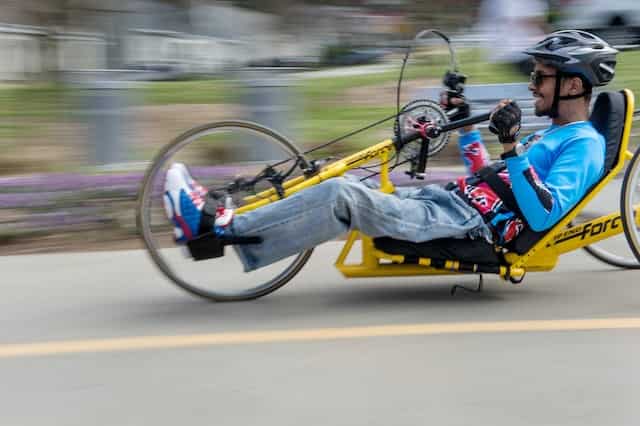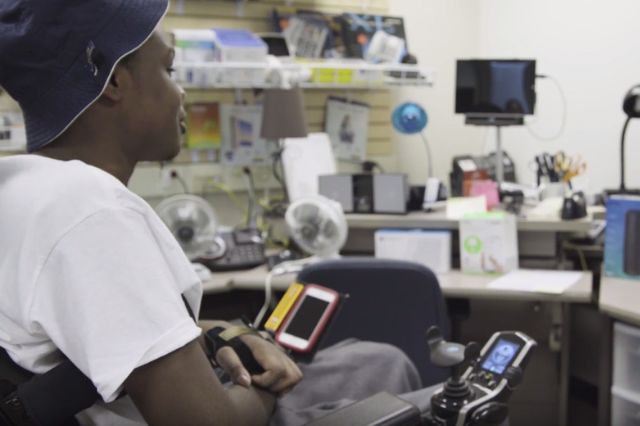Diaphragmatic Pacemaker Assessment
Cutting-edge respiratory care that improves quality of life
At Shepherd Center, we pride ourselves on offering innovative healthcare services. Our respiratory therapy program stands out as one of the few in the nation equipped to offer the Diaphragm Pacing System (DPS), or diaphragmatic pacemaker. This can empower individuals to live more independently, free from the constraints of a ventilator, enhancing their health and functional independence. As a patient, you can trust in our commitment to advancing your journey toward autonomy and well-being.
What is a Diaphragmatic Pacemaker?
People using mechanical ventilation typically experience functional limitations, such as decreased mobility, difficulty speaking, and inherent complications, including infection, tracheal injury, and equipment malfunction. People may be able to receive part-time or full-time respiratory support using a medical device known as a diaphragmatic pacemaker. This device helps people who are unable to breathe on their own and use a mechanical ventilator.
In diaphragm pacing, a lightweight, battery-powered system electrically stimulates your diaphragm muscles and nerves. This causes your diaphragm to contract so that air is pulled into your lungs to help you breathe. The devices for diaphragm pacing include parts both inside and outside the body.
Benefits of a Diaphragmatic Pacemaker
A diaphragmatic pacemaker offers health and quality of life benefits to patients over traditional mechanical ventilators. Patients typically experience the following:
- Improved speech, mobility, and more normal breathing.
- Increased olfactory sensation.
- Greater social interaction.
- Expanded participation in rehabilitation activities.
- Improved occupational opportunities.
Evaluation for a Diaphragmatic Pacemaker
To qualify for a diaphragmatic pacemaker, patients must demonstrate good health and stability. Good health indicators ensure the success of the system and the patient’s long-term outcome.
Requirements to receive a diaphragmatic pacemaker include:
- Recipients must be at least 18 years or older and be committed to treatment.
- People who have a cervical spinal cord injury and are dependent on mechanical ventilation.
- Patients who are clinically stable following an acute spinal cord injury.
- Patients who have a committed primary caregiver. The patient (or a designated representative) and the patient's caregiver will be required to sign a “Patient and Caregiver Agreement” form.
- Female patients (of child-bearing age) must have a negative pregnancy test.
Despite health status, individuals with certain conditions or impairments do not qualify for a diaphragmatic pacemaker. The pacemaker may not be suitable if the patient:
- Has any medical conditions that would interfere with the surgery.
- Has been hospitalized for or treated for an active infection within the past three months.
- Exhibits a significant chest deformity or scoliosis.
Is currently pregnant or breastfeeding. - The patient or their caregiver is not able to comply with the treatment plan.
- The patient’s physician has a reason why they would not be eligible.
Diaphragmatic Pacemaker Implementation
A diaphragmatic pacemaker uses electrodes to stimulate the phrenic nerve, which is the motor innervation to the diaphragm and is responsible for breathing. Laparoscopic surgery implants the electrodes internally.
The external diaphragm pacing device, typically the size of a large remote control, controls the system through connected wires that exit the chest. The implanted electrodes act as a pacing device, causing the diaphragm to contract, just as it would in people with normal connections between the brain and muscles.
This implantable system can provide part-time or full-time respiratory support in place of a mechanical ventilator.
Appointments and Referrals for Diaphragmatic Pacemaker
Located within Shepherd Center in Atlanta, our Respiratory Therapy program is specially designed to offer top-tier respiratory care and support for those dealing with traumatic spinal cord and brain injuries. This focus sets us apart from many rehabilitation hospitals. As a one-stop shop for complex respiratory care, patients can access the most comprehensive services, from a follow-up visit with the pulmonologist to pulmonary function testing, tracheostomy changes, diaphragmatic pacemaker programming, and more.
Frequently Asked Questions
A diaphragmatic pacemaker is a machine that helps improve breathing, speech, and quality of life for people with spinal cord injuries who use a mechanical ventilator. Diaphragm pacing can potentially relieve dependence on a mechanical ventilator.
In diaphragm pacing, a lightweight, battery-powered system electrically stimulates your diaphragm muscles and nerves. This causes your diaphragm to contract so that air is pulled into your lungs to help you breathe. The devices for diaphragm pacing include parts both inside and outside the body.
A diaphragmatic pacemaker offers health and quality of life benefits to patients over traditional mechanical ventilators. Patients typically experience the following:
- Improved speech, mobility, and more normal breathing.
- Increased olfactory sensation.
- Greater social interaction.
- Expanded participation in rehabilitation activities.
- Improved occupational opportunities.
To qualify for a diaphragmatic pacemaker, patients must demonstrate good health and stability. Good health indicators ensure the success of the system and the patient’s long-term outcome. Requirements to receive a diaphragmatic pacemaker include:
- Recipients must be at least 18 years or older and be committed to treatment.
- People who have a cervical spinal cord injury and are dependent on mechanical ventilation.
- Patients who are clinically stable following an acute spinal cord injury.
- Patients who have a committed primary caregiver
- The patient (or a designated representative) and the patient's caregiver will be required to sign a “Patient and Caregiver Agreement“ form.
- Female patients (of child-bearing age) must have a negative pregnancy test.
As an inpatient, you would probably have had the following tests performed already, if not, they are a requirement for the diaphragm pacing treatment:
- Physician and surgeon evaluation for eligibility for treatment
- Chest X-ray
- Lab work, which will be blood tests
- An electrocardiogram (EKG) to check your heart function
Not all risks can be predicted but some of the side effects include:
- Pain and spasms at the surgical site
- The expected risks with any general anesthesia
- Mild nausea after the anesthesia
- Damage to internal organs
Additional Resources for Diaphragmatic Pacemaker
As a leader in rehabilitative care for traumatic brain injury, spinal cord injury, and neurological conditions, Shepherd Center offers specialized information on innovative medical research and treatments. To learn more about our respiratory services, visit MyShepherdConnection, our online source for educational materials.





